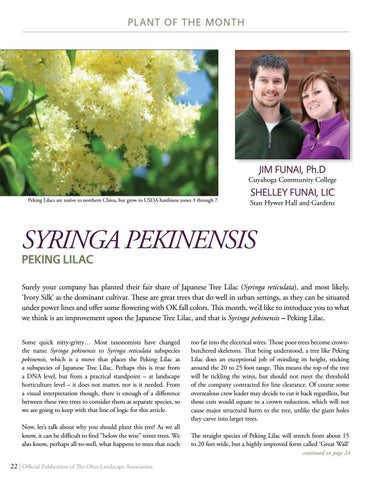PL ANT OF TH E M ON TH
JIM FUNAI, Ph.D Cuyahoga Community College Peking Lilacs are native to northern China, but grow in USDA hardiness zones 3 through 7.
SHELLEY FUNAI, LIC Stan Hywet Hall and Gardens
SYRINGA PEKINENSIS PEKING LILAC
Surely your company has planted their fair share of Japanese Tree Lilac (Syringa reticulata), and most likely, ‘Ivory Silk’ as the dominant cultivar. These are great trees that do well in urban settings, as they can be situated under power lines and offer some flowering with OK fall colors. This month, we’d like to introduce you to what we think is an improvement upon the Japanese Tree Lilac, and that is Syringa pekinensis – Peking Lilac. Some quick nitty-gritty… Most taxonomists have changed the name Syringa pekinensis to Syringa reticulata subspecies pekinensis, which is a move that places the Peking Lilac as a subspecies of Japanese Tree Lilac. Perhaps this is true from a DNA level, but from a practical standpoint – at landscape horticulture level – it does not matter, nor is it needed. From a visual interpretation though, there is enough of a difference between these two trees to consider them as separate species, so we are going to keep with that line of logic for this article. Now, let’s talk about why you should plant this tree! As we all know, it can be difficult to find “below the wire” street trees. We also know, perhaps all-to-well, what happens to trees that reach
too far into the electrical wires. Those poor trees become crownbutchered skeletons. That being understood, a tree like Peking Lilac does an exceptional job of minding its height, sticking around the 20 to 25 foot range. This means the top of the tree will be tickling the wires, but should not meet the threshold of the company contracted for line clearance. Of course some overzealous crew leader may decide to cut it back regardless, but those cuts would equate to a crown reduction, which will not cause major structural harm to the tree, unlike the giant holes they carve into larger trees. The straight species of Peking Lilac will stretch from about 15 to 20 feet wide, but a highly improved form called ‘Great Wall’ continued on page 24
22 | Official Publication of The Ohio Landscape Association






